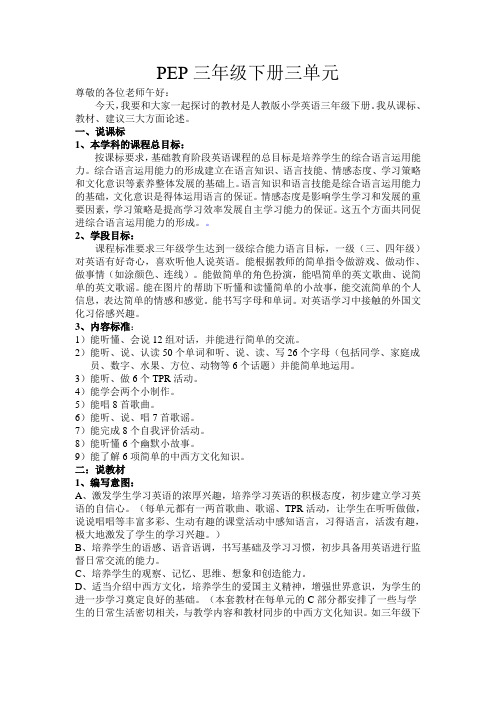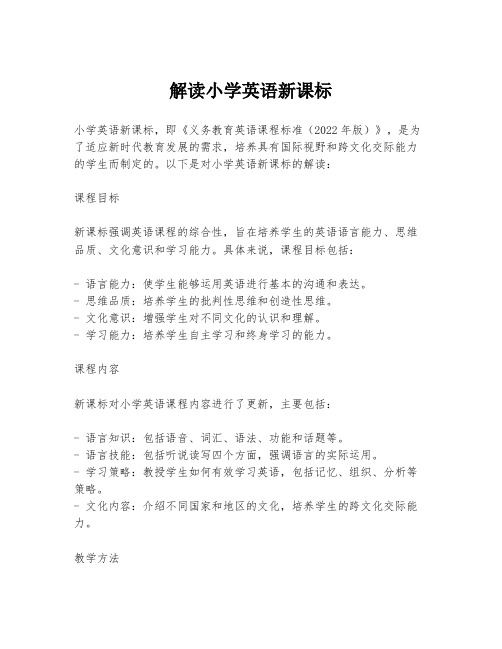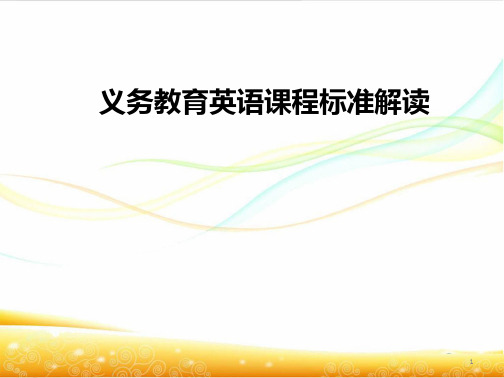新课标解读--小学英语三年级讲课讲稿
小学英语新课标解读详解演示文稿

生“能够做某事”具体描述各级别的要求,这种设计旨在体现基础教育阶 段学生能力发展循序渐进的过程和课程要求的有机衔接,保证国家英语课 程标准的整体性、灵活性和开放性。
(三)突出学生主体,尊重个体差异.课程实施应成为学生在教师指导
下构建知识、提高技能、磨砺意志、活跃思维、展现个性、发展心 智和拓展视野的过程。
第7页,共23页。
第二部分 课程目标
基础教育阶段英语课程的总体目标是培养学生的综合语言运用能力
。综合语言运用能力的形成建立在学生语言技能、语言知识、情感态度 、学习策略和文化意识等素养整体发展的基础上。语言知识和语言 技能是综合语言运用能力的基础,文化意识是得体运用语言的保 证。情感态度是影响学生学习和发展的重要因素,学习策略是提 高学习效率、发展自主学习能力的保证。这五个方面共同促进综 合语言运用能力的形成。
第5页,共23页。
(四)采用活动途径,倡导体验参与.本课程倡导任务型的教学模式,让学生
在教师的指导下,通过感知、体验、实践、参与和合作等方式,实现任务 的目标,感受成功。
(五)注重过程评价,促进学生发展.评价要有利于促进学生综合语言运用 能力和健康人格的发展;促进教师不断提高教育教学水平;促进英语课 程的不断发展与完善。
第20页,共23页。
语法:
1.在具体语境中理解以下语法项目的意义和用法:
• 名词的单复数形式和名词所有格;
• 人称代词和形容词性物主代词;
•一般现在时、现在进行时、 一般过去时和一般将来时; • 表示时间、地点和位置的常用介词; •简单句的基本形式。
2.在实际运用中体会以上语法项目的表意功能。
话题 : 理解和运用有关下列话题的语言表达形式:个人情况、家庭与朋友
新版三年级英语上册教材解说

(5)听录音,或通过VCD来展示Let’s talk部分的教学内容.
学中做
游戏巩固课外延伸
1、猜一猜
选出一名学生背对大家,这时教师指定一名 学生说"Hello"前面的学生从声音辨别(如 辨别是刘辉)要说:Hello, liu Hui. 如猜对 后面的学生这时要说Yes.I am... 如果没猜 对要说 No,I am...
202X
品味书香 共 同成长
--PEP三年级英语教材
孙建停
UNIT 1
教学重难 点
01
新课标的 基本要求
02
教材分析
03
教学目标
04
教学方法 和设计
05
学情分析
06
设想理想 课堂
07
解说流程
新课程总体目标
认识策略
调控策略
学 习
交际策略 策
资源策略 略
综合语言 运用能力
一、英语课程标准要求:
1
歌谣
二、教材分析
1.教材线索
Wu yifan Chen jie
Mike John Sarah
人物 线索
Zip Zoom
Miss White
Mr. Jones
01 Unit1 Hello!
03
Unit5 Let’s eat!
05 话题线索
07
Unit4 We love ainimals
02 Unit2 Colours
Let’s learn ,Let’s do (词汇拓展)
小学PEP三年级英语上册课标解读

PEP小学英语三年级上册教材解读一、课程标准表述1.课程标准对三年级学生要求应达到的目标是什么?提示:课程标准要求三年级学生应达到一级目标。
2.课程标准对三年级学生有哪些方面的要求?提示:有语言知识、语言技能和文化意识三方面的要求。
3.语言知识的一级目标是什么?提示:语言知识的一级目标包括语音目标、词汇、语法、话题目标。
语音目标:知道错误的发音会影响交际;知道字母名称的读音;了解简单的拼读规律;了解单词有重音;语音清楚,语调自然。
词汇目标:学习有关本级话题范围的600-700个单词和50个左右的习惯用语;了解单词是由字母构成的。
语法目标:知道名词有单复数形式;知道主要人称代词的区别;知道动词在不同情况下会有形式上的变化;了解表示时间、地点和位置的介词;了解英语简单句的基本形式和表意功能。
话题目标:能理解和表达有关下列话题的简单信息:数字、颜色、时间、天气、食品、服装、玩具、动植物、身体、个人情况、家庭、学校、朋友、文体活动、节日等。
4.语言技能的一级目标是什么?提示:语言技能包括听、说、读、写、玩演视听。
听:能根据听到的词语识别或指认图片或实物;能听懂课堂简短的指令并做出相应的反应;能根据指令做事情,如:指图片、涂颜色、画图、做动作、做手工等;能在图片和动作的提示下听懂简单的小故事并做出反应。
说:能根据录音模仿说英语;能相互致以简单的问候;能相互交流简单的个人信息,如:姓名、年龄等;能唱英语儿童歌曲15-20首,说歌谣15-20首;能够根据表演猜测意思、说词语;能表达简单的情感和感觉,如;喜欢和不喜欢;能根据图、文说出单词或短句。
读:能看图识字;能在图片的帮助下读懂简单的小故事;能在指认物体的前提下认读所学词语;写:能正确书写字母和单词。
玩演视听:能用英语做游戏并在游戏中用英语进行简单的交际;能做简单的角色表演;能表演英文歌曲及简单的童话剧,如(小红帽)等。
能看懂语言简单的英语动画片或程度相当的教学节目;视听时间每学年不少于10小时(平均每周20-25分钟)。
新课标三年级英语解读

新课标三年级英语解读新课标三年级英语课程是针对小学三年级学生设计的,旨在培养学生的英语基础能力,激发学生学习英语的兴趣,以及帮助学生形成良好的英语学习习惯。
以下是对新课标三年级英语的一些解读:1. 课程目标:新课标强调英语课程的综合性,旨在通过听、说、读、写等语言技能的培养,让学生能够进行简单的英语交流,理解基本的英语信息,以及形成初步的英语思维能力。
2. 语言知识:三年级英语课程注重基础词汇的积累和基本语法结构的掌握。
学生需要学习日常用语、基本词汇和简单句型,为后续学习打下坚实的基础。
3. 语言技能:- 听力:培养学生的听力理解能力,能够听懂简单的英语指令和日常对话。
- 口语:鼓励学生大胆开口,通过模仿、角色扮演等方式,提高英语口语表达能力。
- 阅读:引导学生阅读简单的英语绘本、故事书,培养阅读兴趣和初步的阅读理解能力。
- 写作:初步学习书写字母和单词,能够用简单的英语句子表达自己的想法。
4. 文化意识:通过英语课程,让学生了解英语国家的文化习俗,培养学生的跨文化交际意识。
5. 学习策略:教师应指导学生掌握有效的英语学习策略,如记忆单词的方法、理解句子结构的技巧等。
6. 情感态度:新课标强调培养学生积极的学习态度和对英语学习的兴趣,鼓励学生积极参与课堂活动,享受学习过程。
7. 评价方式:评价不仅关注学生的语言知识掌握情况,也注重学生的语言技能运用能力,以及在学习过程中的情感态度和学习策略。
8. 教学方法:采用情景教学、任务型教学等多样化的教学方法,使学习内容更加生动有趣,提高学生的学习积极性。
9. 资源利用:充分利用多媒体教学资源,如英语歌曲、动画、游戏等,丰富教学内容,提高教学效果。
10. 家庭作业:合理布置家庭作业,确保学生能够在课外巩固和扩展课堂所学知识。
新课标三年级英语课程的设计,旨在通过多元化的教学活动和评价方式,全面提高学生的英语综合运用能力,为学生的终身学习打下良好的基础。
英语研课标说教材说课稿

PEP三年级下册三单元尊敬的各位老师午好:今天,我要和大家一起探讨的教材是人教版小学英语三年级下册。
我从课标、教材、建议三大方面论述。
一、说课标1、本学科的课程总目标:按课标要求,基础教育阶段英语课程的总目标是培养学生的综合语言运用能力。
综合语言运用能力的形成建立在语言知识、语言技能、情感态度、学习策略和文化意识等素养整体发展的基础上。
语言知识和语言技能是综合语言运用能力的基础,文化意识是得体运用语言的保证。
情感态度是影响学生学习和发展的重要因素,学习策略是提高学习效率发展自主学习能力的保证。
这五个方面共同促进综合语言运用能力的形成。
2、学段目标:课程标准要求三年级学生达到一级综合能力语言目标,一级(三、四年级)对英语有好奇心,喜欢听他人说英语。
能根据教师的简单指令做游戏、做动作、做事情(如涂颜色、连线)。
能做简单的角色扮演,能唱简单的英文歌曲、说简单的英文歌谣。
能在图片的帮助下听懂和读懂简单的小故事,能交流简单的个人信息,表达简单的情感和感觉。
能书写字母和单词。
对英语学习中接触的外国文化习俗感兴趣。
3、内容标准:1)能听懂、会说12组对话,并能进行简单的交流。
2)能听、说、认读50个单词和听、说、读、写26个字母(包括同学、家庭成员、数字、水果、方位、动物等6个话题)并能简单地运用。
3)能听、做6个TPR活动。
4)能学会两个小制作。
5)能唱8首歌曲。
6)能听、说、唱7首歌谣。
7)能完成8个自我评价活动。
8)能听懂6个幽默小故事。
9)能了解6项简单的中西方文化知识。
二:说教材1、编写意图:A、激发学生学习英语的浓厚兴趣,培养学习英语的积极态度,初步建立学习英语的自信心。
(每单元都有一两首歌曲、歌谣、TPR活动,让学生在听听做做,说说唱唱等丰富多彩、生动有趣的课堂活动中感知语言,习得语言,活泼有趣,极大地激发了学生的学习兴趣。
)B、培养学生的语感、语音语调,书写基础及学习习惯,初步具备用英语进行监督日常交流的能力。
解读小学英语新课标

解读小学英语新课标小学英语新课标,即《义务教育英语课程标准(2022年版)》,是为了适应新时代教育发展的需求,培养具有国际视野和跨文化交际能力的学生而制定的。
以下是对小学英语新课标的解读:课程目标新课标强调英语课程的综合性,旨在培养学生的英语语言能力、思维品质、文化意识和学习能力。
具体来说,课程目标包括:- 语言能力:使学生能够运用英语进行基本的沟通和表达。
- 思维品质:培养学生的批判性思维和创造性思维。
- 文化意识:增强学生对不同文化的认识和理解。
- 学习能力:培养学生自主学习和终身学习的能力。
课程内容新课标对小学英语课程内容进行了更新,主要包括:- 语言知识:包括语音、词汇、语法、功能和话题等。
- 语言技能:包括听说读写四个方面,强调语言的实际运用。
- 学习策略:教授学生如何有效学习英语,包括记忆、组织、分析等策略。
- 文化内容:介绍不同国家和地区的文化,培养学生的跨文化交际能力。
教学方法新课标提倡以学生为中心的教学方法,强调以下几点:- 活动化教学:通过游戏、角色扮演等活动,激发学生的学习兴趣。
- 任务型教学:设计贴近学生生活的任务,让学生在完成任务的过程中学习英语。
- 合作学习:鼓励学生之间的合作,通过小组讨论、合作完成任务等方式提高学习效果。
评价方式新课标对小学英语的评价方式进行了改革,主要包括:- 形成性评价:注重过程评价,通过课堂观察、学生自评等方式,及时了解学生的学习情况。
- 终结性评价:通过期末考试、口语测试等方式,综合评价学生的学习成果。
- 多元化评价:鼓励使用多种评价方式,如同伴评价、自我评价等,全面了解学生的学习情况。
课程资源新课标鼓励教师和学校充分利用各种资源,包括:- 教材:选择符合新课标要求的教材,注重教材的实用性和趣味性。
- 多媒体资源:利用网络、多媒体等现代教育技术,丰富教学内容和形式。
- 社区资源:利用社区文化、历史等资源,为学生提供真实的语言学习环境。
课程实施新课标对课程实施提出了以下建议:- 教师培训:加强教师对新课标的理解和应用能力,提高教学质量。
新课程标准解读(小学英语培训)PPT课件

四、关注英语课程理念的变化
课程理念是我们确定教学目标、进行教学 设计、确定教学内容和标准,选择教学方法、 进行教师培训、开展教学评价的重要依据。
18
四、关注英语课程理念的变化
(英语课程基本理念,2001)
1 面向全体学生,实施素质教育 2 整体设计目标,体现灵活开放 3 突出学生主体,尊重个体差异 4 倡导积极学习,采用活动途径 5 改进评价体系,促进学生发展 6 开发课程资源,拓展学用渠道
文化意识
文文跨 化化文 知理化 识解交
际
标
语言技能
语言知识
听说读写
语词语功话 音汇法能题
32
如何理解义教阶段英语课程总目标?
综合语言运用能力建立在语言技能、语言知识、 情感态度、学习策略和文化意识等诸方面整体发展的 基础之上。语言知识和语言技能是综合语言运用能力 的基础;文化意识有利于正确地理解语言和得体地使 用语言;有效的学习策略有利于提高学习效率和发展 自主学习能力;积极的情感态度有利于促进主动学习 和持续发展。
28
英语课程设计
29
英语课程的总体设计思路
这一课程体系以培养学生的综合语言运用能 力为目标,使英语课程既重视培养学生的语言基 础知识和基本技能,也注重优化学习过程,引导 学生形成有效的学习策略和较强的文化意识,培 养积极向上的情感态度和价值观。
30
英语课程目标
- 总目标
➢总目标提供目标总体框架架构
22
3、整体设计目标,充分考虑语言学习的渐进性和持续性
英语学习具有明显的渐进性和持续性特 点。语言学习持续时间长,而且需要逐渐积累。《义 务教育英语课程标准》和与之相衔接的《普通高中英 语课程标准》将基础教育阶段英语课程的目标设为九 个级别,旨在体现小学、初中和高中各学段课程的有 机衔接和各学段学生英语语言能力循序渐进的发展特 点,保证英语课程的整体性、渐进性和持续性。英语 课程应按照学生的语言水平及相应的等级要求组织教 学和评价活动。
小学三年级英语课教学优秀说课稿3篇

小学三年级英语课教学优秀说课稿3篇英语基础教育最主要的任务是要学会学习,开发自主学习能力,培养创新能力。
在整体构思、内容安排、活动设计和教学方法都采用了与学生紧密联系的生活实际,真正体现了语言的交际功能。
以下是小编整理的小学三年级英语课说课稿3篇,希望可以分享给大家提供参考和借鉴。
小学三年级英语课说课稿一《We Love Animals》一。
教材分析:本次说课我所使用的教材是义务教育课程标准实验教科书,小学三年级上册第四单元We Love Animals。
本套教材非常注重学生语言应用能力的培养,从学生的角度来讲,基础教育最主要的任务是要学会学习,开发自主学习能力,培养创新能力。
本教材在整体构思、内容安排、活动设计和教学方法都采用了与学生紧密联系的生活实际,真正体现了语言的交际功能,同时,它把知识和技能目标融会在了完成任务的过程之中,从而体现出了英语新课标提出的把话题---功能---结构---任务结合起来的总思路,为培养学生运用英语进行交流打下良好的基础。
1.本课教学内容:○1. Let s learn本部分主要是学习常见动物单词 cat dog monkey duck panda rabbit○2. Let s talk学习句型I have a 以及Super! Cool! Wow! Great!等表示赞美的感叹词语。
○3. Let s do.本部分要求学生在“Act like a”的指令下模仿小动物的动作。
2.本课教学目标: (知识目标、能力目标、德育目标)知识目标○1.能听懂,会说Look! I have a 并能在实际情景中运用。
○2能听说,认读一些常见的动物单词。
○3能听懂,会说几个常用的感叹词 Super!Cool!Wow!Great!并能够在实际情景中运用。
○4能听懂简单的指示语,并能按照指令模仿动物做出相应的动作。
能力目标:提高学生听、说、读、写的综合能力。
德育目标:教育学生要爱护和保护小动物。
- 1、下载文档前请自行甄别文档内容的完整性,平台不提供额外的编辑、内容补充、找答案等附加服务。
- 2、"仅部分预览"的文档,不可在线预览部分如存在完整性等问题,可反馈申请退款(可完整预览的文档不适用该条件!)。
- 3、如文档侵犯您的权益,请联系客服反馈,我们会尽快为您处理(人工客服工作时间:9:00-18:30)。
小学英语新课标解读
为培养和适应本国和世界所需要的新一代人才,对外语教育的意义和价值要有新的认识。
外语教育的目的是为今后的公民在多元文化的地球村中生存和发展做准备。
而作为基础教育实施者的小学英语教师更应该有自己独特的思想,能够把握教学的核心,在具体教学活动中有自己独特的思考。
再读《新课标》,我想站在一名一线教师的角度,对新课标做属于自己的解读:
一.要面向全体学生:
面向全体学生,注重素质教育是国家义务教育阶段的基本要求,教师面对的不仅是学生的个体,更要面对的是智力水平和情感因素都各不相同的学生群体。
新课标特别强调要关注每个学生的情感,激发他们学习英语的兴趣,帮助他们树立自信和成就感,同时尊重个体差异,倡导体验,参与,课程提倡任务型教学模式,通过感知,体验,实践,参与和合作等方式,帮助学生感受成功。
二.
三.
四.为完成课程目标创设合适的教学设计和课堂氛围:
基础教育阶段英语课程的总体目标是培养学生的综合
语言运用能力,目标的各个级别均以学生语言技能,语言知识,情感态度,学习策略和文化意识五个方面的综合行为表现为基础进行总体描述。
按照这个目标,小学毕业英语水平应达到二级标准,即对英语学习有持续的兴趣和爱好,能用简单的英语互致问候,交换有关个人,家庭和朋友的简单信息,能根据所学内容表演对话或歌谣,能在图片帮助下听懂,读懂并讲述简单的故事,能根据图片或提示写简单的句子,在学习中乐于参与,积极合作,主动请教,乐于了解异国文化和习俗。
为了帮助学生完成课程目标,教师应在教学设计中尝试有效的教学方式:
1.
2.
3.要创设自主,合作,探究的学习方式:
课标中强调的教学过程是师生交往,共同发展和互动学习的过程,教师在注重培养学生独立自主的同时,还要引导学生质疑,调查,探究,在合作中学习,让学生的学习过程成为教师指导下主动的,富有个性的过程,并更多地培养学生发现,提出,分析和解决问题的能力。
4.
5.
6.
7.要创设以人为本的情境教学:在小学英语教学中,兴趣,情境,活动是三个非常重要的因素,兴趣是学习英语的动力,活动是提高小学生英语应用能力的主要途径。
教师要保持学生学习英语的兴趣,就必须内外兼修,提高自己的业务基本功,让语言本身吸引学生,同时应该设计有情境和语境的对话活动,使语言生活化,趣味化和真实化,让语言交际成为维持和沟通的桥梁,这样才能让英语这种生疏的第二语言随时绽放在学生的口齿之间。
8.
9.
10.
11.要培养学生语言的综合学习能力:教师传授英语的过程,是学生增长知识,掌握技能,学习文化,提高语言运用能力的过程,也是他们丰富情感,陶冶情操,展开联想,进行创造性思维的过程,因此在课堂上要培养学生的创新精神和实践能力,抓好语言技能训练,促进学生综合语言运用能力的发展,培养学生的观察,思维及想象力,注重营造生动的理念,活泼的课堂。
比如小学英语中对中西方文化差异的学习和了解。
新课标的二级标准为:知道英语中最简单的称谓语,问候语和告别语,对赞扬,请求做出适当的反应,知道国际上重要的文体活动,知道主要英语国家的首都和国旗
等等,这些学习都能帮助学生拓展视野,提高跨文化交际能力,也是一种语言综合能力的培养。
12.要设计灵活有效的任务型教学:
任务型教学侧重语言的内容大于语言形式结构,它强调让学生在完成任务的过程中学习语言,设计的任务不仅要有交际性,还要贴近学生生活,学习的经历和社会实际,这样才能引起学生的共鸣和兴趣。
在设计时应注意趣味性,情感性,宽容性和学科融合性。
课标中也提出这种教学模式要在学术的学习过程中进行情感和策略调整,以形成积极的学习态度,促进语言实际运用能力的提高。
五.
六.要有多样化的教学评价方式:
新课标提出要建立能激励学生学习兴趣和自主学习能力发展的评价体系。
英语教学应以形成性评价为主,注重培养和激发学生学习的积极性和自信心,评价要有利于促进学生综合语言运用能力和健康人格的发展,促进教师不断提高教育教学水平和英语课程的不断发展与完善,同时要充分体现教学评价的人文性,过程性,开放性,激励性和多元性。
以上是我对《小学英语新课程标准》的自我解读,解读内容还有待在课堂教学中不断检验和修正。
卫岗小学英语组:沈静
2013.8.1。
